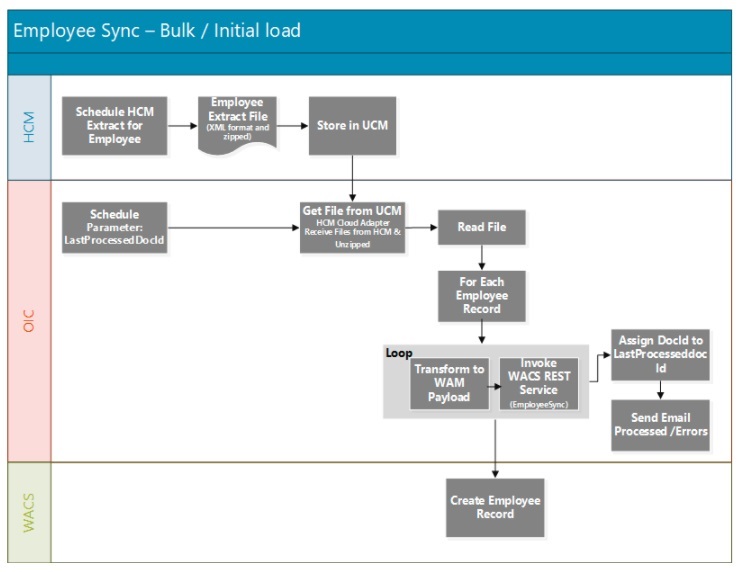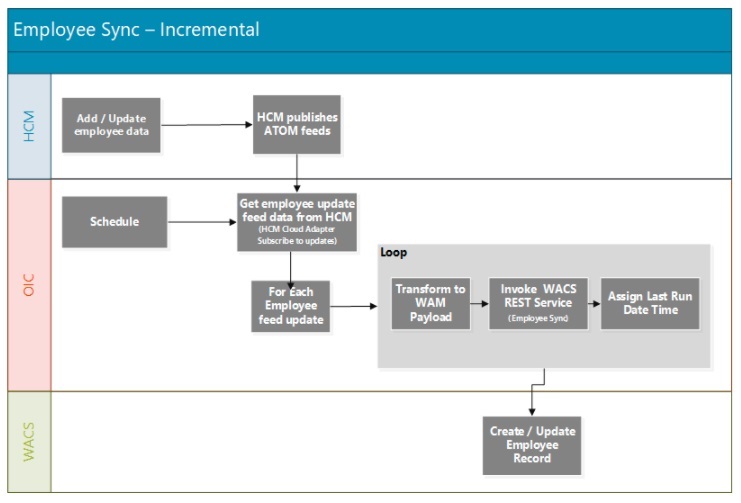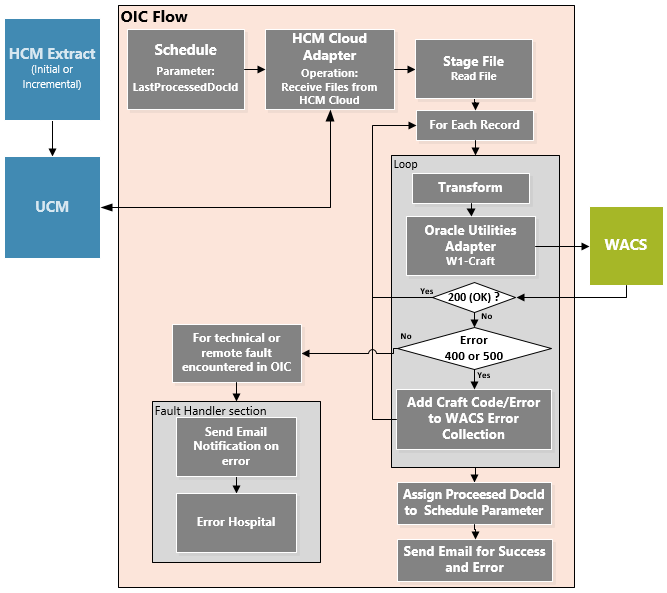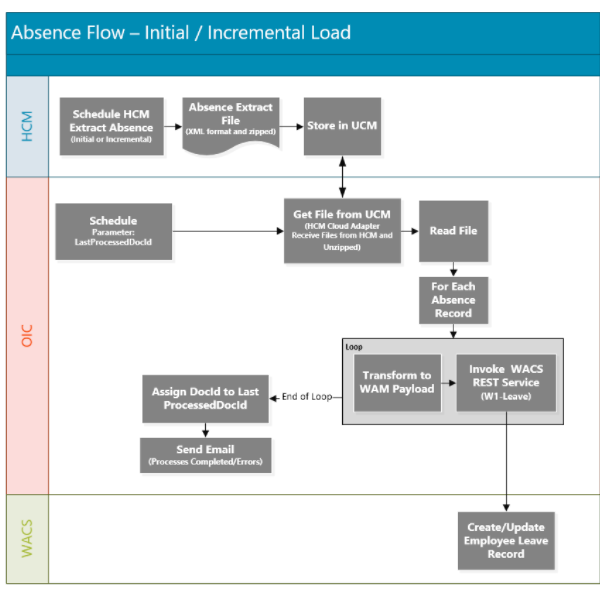About Oracle Human Capital Management
Employee Integration
The objective of the Employee interface is to synchronize employee records originating in Oracle Human Capital Management to Oracle Utilities Work and Asset Cloud Service.
In the initial bulk process, all active employee records are extracted and sent to the Oracle Utilities Work and Asset Cloud Service. For incremental updates, as employee records are updated within the Oracle Human Capital Management application, the records are extracted and sent to Oracle Utilities Work and Asset Cloud Service. These incremental updates include changes to employee basic information and assignment, creation of new employees and termination of existing employees by inactivating their employee records.
These employee records can then be referenced by the Employee Absence (Leave) Integration. Each Employee is assigned a Job (Craft), and each Absence (Leave) request applies to an Employee.
Initial Bulk Employee Sync
HCM Extract that is designed in the data exchange is ran to create the employee extract file that is stored in the universal content manager (UCM).
The selection of the employees in the Oracle Human Capital Management module to synchronize to Oracle Utilities Work and Asset Cloud Service is controlled by filters. The business may choose to import all employee records from Oracle Human Capital Management or select the filtering criteria based on Legal Entity, Business Unit or Cost Centers. The extract file will be based on filtering criteria selected and Employee Status is “Active”.
A few examples of attributes that will be passed to Oracle Utilities Work and Asset Cloud Service in this integration are personal number, legal entity, address, email ID, employee type, rate, assignment and job role.
Oracle Integration Cloud Bulk Employee Sync Process is scheduled to pick the file from UCM, transforms the payload and invoke the Employee Sync REST endpoint of Oracle Utilities Work and Asset Cloud Service to synchronize the employee information.
The following diagram shows the initial bulk employee end-to-end synchronization process:

Incremental Employee Sync
The incremental updates to any changes in employee information, new hire or terminated employees are handled through ATOM feed. Four feeds are available in the Oracle Human Capital Management cloud that will be used in this employee integration.
ATOM feed for Employee:
• empAssignment
• empUpdate
• newHire
• termination
For more information about Oracle Human Capital Management cloud, see:
https://docs.oracle.com/en/cloud/saas/human-resources/20a/farws/Employee_Atom_Feeds.html
https://docs.oracle.com/en/cloud/saas/human-resources/20a/farws/Employee_Atom_Feeds.html

Jobs (Crafts) Integration
The objective of the Jobs interface is to synchronize the job records originating in Oracle Human Capital Management to Oracle Utilities Work and Asset Cloud Service as craft records.
In the initial bulk process, all active job records are extracted, and sent to the Oracle Utilities Work and Asset Cloud Service.
For incremental updates, as the job records are updated within Oracle Human Capital Management, the records are extracted and sent to the Oracle Utilities Work and Asset Cloud Service. These updates include changes to job information, changes to the job record status and newly activated jobs. The resulting craft records can then be referenced by the Employee Integration, and within the Oracle Utilities Work and Asset Cloud Service application referenced as a resource for Work Management.
The following diagram shows the end-to-end synchronization process:

Maintenance of Jobs
Oracle Human Capital Management is the master for Jobs information. Creation and updates to job information are done in this application.
Jobs Data Extract
The HCM Data Extract is used to extract the job information from Oracle Human Capital Management applications by generating a job data file created in XML format and stored in UCM. The extract can be scheduled to run as per the business requirements.
The same HCM Jobs Data Extract is used to synchronize both bulk and incremental sync.
The extract has the following criteria as configuration:
• Effective Date: Mandatory
JOB BIP report extracts data based on the effective date and should be decided before executing/scheduling the report.
• Job Set (Based on Legislative Unit: Can be global or specific to one legislative unit): Mandatory
• Legislative Group
• Changes Only
• Choose “All Attributes” when running the initial load. For initial load, only jobs in ‘Active’ status are interfaced.
• Choose “Changed and marked attributes” when running incremental load. For incremental load, both ‘Active’ and ‘Inactive’ jobs are interfaced.
• WACS JOB (Flexfield is set to YES): Report Parameter as filter
For information about how to create Job Set, Profile, EFF and sample Job Records, refer to the Oracle Human Capital Management Cloud Configurations for Oracle Human Capital Management Cloud Integration to Oracle Utilities Work and Asset Cloud Service Setup Guide included in this release.
Jobs (Crafts) Synchronization
Oracle Integration Cloud gets the extract file from UCM server, transforms the data and invokes the Craft Synchronization REST service to synchronize the craft and craft rate information in Oracle Utilities Work and Asset Cloud Service.
After all jobs records are processed, Document ID (docId) of the processed file is assigned to the flow’s schedule parameter LastProcessedDocId. This enables the integration process to use this value to get the next file when the integration process is executed again.
Employee Unavailability (Absence or Leave) Integration
The objective of the Employee Unavailability (Leave) interface is to integrate Absence records originating in Oracle Human Capital Management with Employee Unavailability within the Oracle Utilities Work and Asset Cloud Service. In the initial, bulk process, all approved Absence records are extracted, processed, and sent to the Oracle Utilities Work and Asset Cloud Service. For incremental updates, as the Absence records are updated within Oracle Human Capital Management, the record is extracted, processed, and sent to the Oracle Utilities Work and Asset Cloud Service. These updates include canceled requests. These Employee Unavailability records can then be used in the Planning process for Work Management.
The scope of the absence integration is bulk data (initial) and incrementally based on the following approach. Bulk data would be uploaded initially and thereafter only incremental (changes/new/updated) absence records would be interfaced to Oracle Utilities Work and Asset Cloud Service system.
The following diagram shows the end-to-end synchronization process:

Maintenance of Employee Absences
Oracle Human Capital Management is the master for Employee Absence information. Creation and updates to absences information are done in this application.
Absences Data Extract
HCM Data Extract is used to extract the employee absence information from the Oracle Human Capital Management applications by generating an absence data file created in XML format and stored in UCM. The extract can be scheduled to run as per the business requirements.
The extract has the following criteria used as configuration:
• Effective Date (Mandatory)
• Absence report extracts the data based on effective date and should be decided before executing/scheduling the report.
• Legislative Entity Name (Mandatory)
• Filter for Employee and Employee Unavailability extract is the same, based on Legal Entity, business Unit, or Cost Center.
• Changes Only
• Choose “All Attributes” when running the initial load.
For initial load, only “Approved (Scheduled and In Progress)” absences are interfaced. This will include future applied leaves as well.
• Choose “Changed and marked attributes” when running the incremental load.
For incremental load, “Approved (Scheduled, In Progress, Completed)” and “Cancelled (Awaiting withdrawal approval and Withdrawn)” absences are interfaced.
Employee Absence Synchronization
Oracle Integration Cloud gets extract file from UCM server, transforms the data and invokes the Leave Synchronization REST service to synchronize the employee absences (leave) information in Oracle Utilities Work and Asset Cloud Service.
After all the absence records are processed, the Document ID (docId) of the processed file is assigned to the flow’s schedule parameter LastProcessedDocId. This enables the integration process to use this value to get the next file when the integration process is executed again.